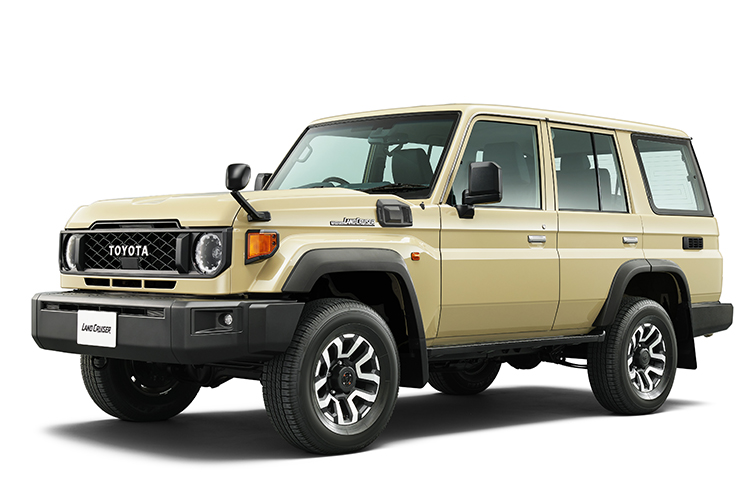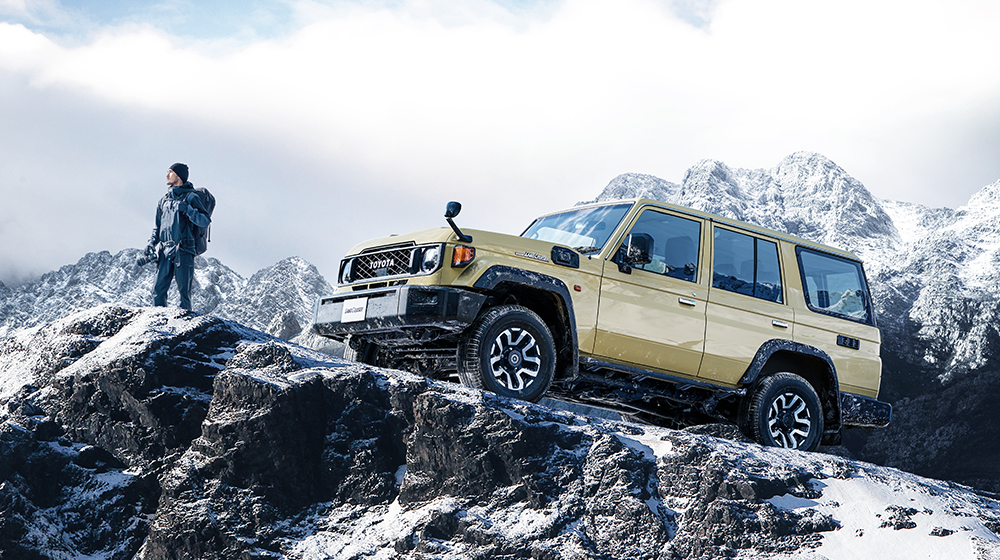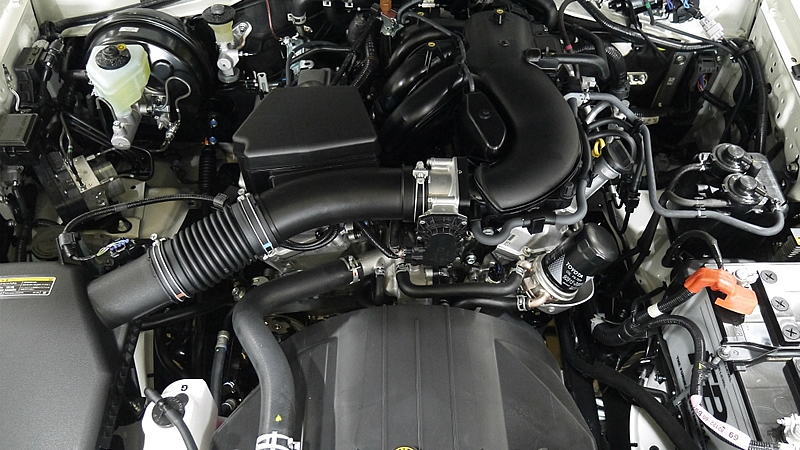What is the Land Cruiser 70?
The No. 1 heavy-duty model of all time
The Land Cruiser 70 is the heavy-duty model in the Land Cruiser series. Released in 1984, it was the successor of the 1960 Land Cruiser 40, which had been on sale for 24 years. It is heavy-duty because it is built for hard use in harsh environments which meant it would last longer than regular cars.
Up to this point, Land Cruiser 40 had become dissatisfactory to its users. To meet the demand for something different, Toyota was busy creating a style and increasing production. The end of the 40 model saw many problems like user complaints about poor ride comfort, lack of engine power, leaks, and body rust. Because the LC40 started in the 1960s, it was inevitable that there would be dissatisfaction with it by the 1980s.
Following the Land Cruiser 40, the Land Cruiser 70, including the Land Cruiser 80 that debuted at the same time and the 70 light series (later Prado) derived from the Land Cruiser 70, was based on an impressive plan to build a new era of Land Cruisers worldwide.
Toyota was committed to thoroughly fixing all of the problems. Everything, including the frame and body, was redesigned to dramatically increase durability and improve usability. After its debut, it has undergone repeated changes such as new AT settings, a complete change to the diesel engine, an expansion of features and models, and major improvements to the suspension.
However, sales in Japan ended in July 2004 due to diesel engine emission regulations and sluggish sales performance. For markets other than Japan, the pickup model continued to sell after further improvements such as the extension of the single cabin, the addition of a V8 diesel engine, the refinement of the front part of the body due to the expansion of the engine room, and the improvement of collision safety and passenger protection performance.
The voices of Japanese fans that missed the Land Cruiser 70 were loud, and in commemoration of its 30th anniversary in 2014, the Land Cruiser 70 was produced for one year only from August 2014 until June 30, 2015.
Land Cruiser 70 domestic model body size & specification comparison
November 1984 – July 2004 Production model
| Car Model | Land Cruiser 70 short | Land Cruiser 70 middle | Land Cruiser 70 semi long |
|---|---|---|---|
| Sales Period | November 1984 to July 2004 | November 1984 to July 2004 | January 1990 to July 2004 |
| Full Length | 159 inches | 177 inches | 190 inches |
| Full Width | 67 inches | 70 inches | 70 inches |
| Full Height | 75 inches | 77 inches | 76 inches |
| Minimum Turning Radius | 213 inches | 232 inches | 244 inches |
| Vehicle Weight | 4,233-4,255 pounds | 4,431-4,586 pounds | 4,674-4,762 pounds |
| Boarding Capacity | 2/5 people | 2/5 people | 5 people |
| Engine Type | Diesel: 3.4L (straight 4: 3B) / 3.4L (straight 4 turbo: 13B-T) / 3.5L (straight 5: 1PZ) / 4.2L (straight 6: 1HZ) | Diesel: 3.4L (straight 4: 3B) / 3.4L (straight 4: 13B-T) / 4.2L (straight 6: 1HZ) | Diesel: 3.5L (straight 5: 1PZ) / 4.2L (straight 6: 1HZ) |
| 4WD System | Part-time | Part-time | Part-time |
| MSRP | $17,900-$21,500 | $19,200-$21,800 | $21,200-$22,300 |
* Specs are typical final model
*Vehicle weight does not include optional equipment
*The price when new is the manufacturer’s suggested retail price (tax included) of the final model.
Middle models have an FRP top only, and short has a hood
The Land Cruiser 70 was originally only available in two models: a 2-door short with a wheelbase of 2310mm/91 inches and a 2-door middle with a wheelbase of 2600mm/102 inches. At this time, it was still equipped with two types of engines: an improved version of the 3.4-liter in-line 4 diesel engine of the previous Land Cruiser 40 and a turbo version of it.
The first big change was in 1990, right after the Land Cruiser 80 debuted. A 4-door semi-long model with a wheelbase of 2730mm/107 inches was added to the lineup and the engine was improved. The short was equipped with a 3.5-liter inline 5 diesel, the middle with a 4.2-liter inline 6 diesel engine, and the semi-long with both diesel engines. By the way, the name “semi-long” comes from the fact that there was a “long” with a longer wheelbase in overseas specifications.
After the 3 body lineup, the trim levels increased, and in addition to the previous STD (standard) and LX, a higher trim level ZX with overfenders and wide tires was introduced. However, the two-engine system did not last long, and in 1994 all models were unified with a 4.2-liter inline 6 diesel engine in response to the tightening of diesel exhaust gas regulations in Japan.
In 1999, the Land Cruiser 70 underwent minor changes such as coiling the front suspension spring. The Land Cruiser 70 sold in Japan ends domestic sales in 2004 with almost the same specifications as the minor change of 1999. The Land Cruiser 70 was part of the new Land Cruiser 1990s era, but the market still considers cars as tools. The high-end ZX has a different interior design from other models and the body was a metallic color. Simple features such as a manual air-conditioning system that used a lever to adjust the temperature, a part-time 4WD drive system without an electronic control unit, and a fabric-only seat with no power function were standard until the end of the model lineup.
Land Cruiser 70 limited-time retail model
August 2014 to June 2015
| Car Model | Land Cruiser 70 middle (van) | Land Cruiser 70 long (pickup) |
|---|---|---|
| Full Length | 189 inches | 207 inches |
| Width | 74 inches | 70 inches |
| Height | 76 inches | 77 inches |
| Wheelbase | 107 inches | 125 inches |
| Minimum Turning Radius | 248 inches | 283 inches |
| Vehicle Weight | 4,674 pounds | 4,894 pounds |
| Boarding Capacity | 5 people | 5 people |
| Engine Type | Gasoline: 4.0L (V6: 1GR-FE) | Gasoline: 4.0L (V6: 1GR-FE) |
| 4WD System | Part-time | Part-time |
| MSRP | $26,000 | $25,000 |
*Vehicle weight does not include optional equipment
*The price when new is the manufacturer’s suggested retail price (tax included).
The Land Cruiser 70 retail model revived with a V6 engine
Two models, a 4-door van and a double cab pickup, were released for a limited time to commemorate the 30th anniversary of the Land Cruiser 70. The van used to be a semi-long model with a wheelbase of 2730mm/107 inches, which also existed in Japan, and the double cap pickup was a long model with a wheelbase of 3180mm/125 inches. Both of them have wide faces around the front, which was their first appearance in Japan.
It is powered by the 1GR-FE 4.0 liter V6 gasoline engine, which is the same engine in the FJ Cruiser and Tacoma that is sold in North America. There was a time when the same engine was also on the Land Cruiser 150 Prado, but even though the 1GR-FE on the 150 Prado was equipped with dual VVT-i (variable intake/exhaust valve control), it was installed on the Land Cruiser 70.
The type of engine control is subtly different depending on the corresponding emission regulations and the character of the model. This V6 engine is flexible, and there are examples of installation in overseas models such as the 4Runner and the Land Cruiser 200. The commemorative model was equipped with a 5-speed manual only.
A triple cone synchro was adopted for the 2nd and 3rd gears that enabled smooth shifting. The 4WD system is a part-time type that switches between 4WD and 2WD, high range and low range by operating the transfer lever as before. The front freewheel hub is also a durable design that can be switched between auto and manual. Safety equipment includes SRS airbags in the driver and front passenger seats, and ABS as standard equipment. A total of about 7,000 Land Cruiser 70s were registered in Japan during the year of limited sales.
Changes in Land Cruiser 70 specifications and equipment
November 1984
The Land Cruiser 70 succeeded the Land Cruiser 40. The engine is only a 3.4L straight 4 diesel brought over from the 40 series. There are two types of bodies: 2-door short and 2-door middle.
October 1985
Toyota added a turbocharged 3.4L straight 4 diesel engine. Until then, the transmission was only MT, and a new 4-speed AT was set for the upper models.
January 1990
The lineup was reviewed, and a 3.5L straight 5 diesel engine was added for the short model, and a 4.2L straight 6 diesel engine was added for the middle model. The B series diesel engine of the 1940s was discontinued.
April 1990
A 4-door semi-long version was added to the lineup. In addition to the 3.5L straight 5 diesel engine, the high-end model uses the 4.2L straight 6 diesel engine that is also installed in the Land Cruiser 80.
April 1992
The 4-speed AT is electronically controlled. To improve safety, a side door beam is installed inside the door, and a high-mounted brake light is used on the rear.
January 1994
The 3.5L in-line 5 diesel engine installed in the short and semi-long models was discontinued, and the 4.2L in-line 6 diesel engine was standardized for all models.
January 1995
Toyota changed the grill design. The badge was changed from “TOYOTA” to “T mark”.
August 1999
Toyota changed the front suspension spring from leaf to coil. Along with that, the axle was also adapted for coil springs. The front grill has a three-dimensional horizontal slit design. Until then, the electrical equipment, which was 24V like trucks, was changed to 12V. In addition, many improvements have been made to the engine, 5-speed MT, brakes, and front and rear seats.
August 2001
To meet the 2000 noise regulations, the undercover of the engine was changed to a large plastic one.
July 2004
Japanese domestic vehicle sales ended.
August 2014
The retail model commemorating the 30th anniversary of the Land Cruiser 70 is back in Japan for a limited time. Two models, a 4-door van semi-long and a 4-door long double cab pickup are available. The engine is a 4.0L V6 gasoline, and the transmission is a 5-speed MT only.
June 2015
Land Cruiser 70 engine type
The Land Cruiser 70 started with a 3.4-liter inline 4 diesel 3B (98PS/96HP, 23.0kgm), which was an improved Land Cruiser 40 engine, and a 4-cylinder inline 4 diesel turbo 13B-T (120PS/118 HP, 29.0kgm). Both cylinder heads are OHV, and depending on whether they have a turbo or not, there is a difference in output characteristics, as well as a difference in models. However, for the Land Cruiser 70, which is an increased heavy-duty vehicle, it is undeniable that both engines are lacking in capability, and the next generation engine is eagerly awaited.
With the addition of the 4-door semi-long car, the engine was revamped, and the 5-cylinder and 6-cylinder era lasted for about 4 years. At this time, the 3.5-liter inline 5 diesel 1PZ (115PS/113HP, 23.5kgm) and 4.2-liter inline 6 diesel 1HZ (135PS/133HP, 28.5kgm) were so-called modular engines, and the 1PZ had the same structure as the 1HZ but with one less cylinder. The engine changed completely from the 4-cylinder era, and the cylinder head evolved to an OHC. Torque has increased, and even though it is non-turbo, it is compatible with high-speed rotation, and the horsepower is one class higher.
The last is the 6-cylinder 1 model era, which was only a 4.2 liter straight 6 diesel 1HZ from 1994. With a high compression ratio of 22.7 and the ability to deliver a lot of torque, models equipped with this engine are quite popular.
The times changed, and the Land Cruiser 70 was revived as a limited model in 2014 to commemorate its 30th anniversary. It didn’t come with a diesel engine, but it did have a 4.0-liter V6 gasoline 1GR-FE, which has a reputation for being robust. The cylinder head is a DOHC, and of course, the maximum rotation height is beyond the reach of diesel engines, and the maximum torque is originally 36.7kgm/265lb.-ft., so it demonstrates 170PS/163HP at 5200rpm. Compared to the FJ Cruiser, which is equipped with the same type of V6 gasoline engine, there are differences in vehicle weight and suspension, so the Land Cruiser 70 cannot be expected to be crisp and comfortable. However, this V6 gas engine indeed makes the Land Cruiser 70 nimbler than the previous diesel era.
Land Cruiser 70 Test Drive Impression & Report
The wheelbase makes a huge difference in maneuverability
If the Land Cruiser 70 has a diesel engine and you use the low-speed range, it is capable of a strong showing both on and off-road.
The 4.2 liter inline 6 diesel engine is the most popular in the used car market, but if this engine is turned too much, the torque will drop due to the nature of the large displacement non-turbo diesel, and the response will be dull.
With a 5-speed MT installed, you can conquer most of the terrain you encounter off-road if you use the rotation range around 2000rpm where maximum torque is exhibited. The V6 gasoline engine limited model has a higher maximum torque value than the 4.2-liter inline 6 diesel engine, but it cannot compete with the diesel engine in terms of tenacity in the low rotation range. It will be a lot more fun to run with a moderate rotation.
In addition, the maneuverability varies greatly depending on the difference in body length and minimum turning radius. The minimum turning radius of the Land Cruiser 70 is 5.4m/213 inches for the short, 5.9m/232 inches for the middle, 6.2m/244 inches for the semi-long (6.3m for the limited model), and 7.2m/283 inches for the double cab long. The Land Cruiser 200 measures 5.9m/232 inches, which is on par with the smaller Land Cruiser 70 Middle. Semi-long and above are beyond the category of general cars and cannot turn in a small radius. Be careful in narrow city alleys and off-road.
Ride comfort and steering stability are better with a longer wheelbase due to the stability. The front suspension springs were changed in August 1990, but the coils after that are superior to the previous leaf in terms of ride comfort and steering stability.
In addition, it is generally said that off-road vehicles with a short wheelbase have better running performance because they do not hit the underside when the terrain changes, but this is not the case. For example, when approaching an uphill terrain with steps of equal height, a car with a short wheelbase will experience large changes in position and become unstable, making it easier for the tires to lose grip. On the other hand, a car with a long wheelbase tends to get stuck on steps and not be able to move forward, even if there is little change in position. Off-road driving is where you can’t simply decide which one is the best.
The way you approach the terrain and your custom styling can make any wheelbase car more capable off-road. In a custom with a lift kit, a car with a relatively long wheelbase will be able to secure excellent total balance.
Land Cruiser 70 tips for choosing a used car
Used car market with a surprising number of 30th-anniversary models
The Land Cruiser 70 on the used car market is generally expensive. Most of them are relatively new models after 1990 when the front suspension was equipped with a coil spring, but there are a surprising amount of Limited Edition models that were released in 2014. However, due to emission regulations, diesel vehicles up to 2004 can only be registered in limited areas, so if you are a fan living in an urban area, you will probably want to look for one of the gas-powered limited vehicles.
If you live in a region that does not have diesel emissions regulations, you can find many older models in good condition for the durable Land Cruiser 70. The used car price is between $7,210 and $28,850 for a diesel engine car with a front coil spring. 2014 Limited Edition van and double cab seem to be priced between $23,000 and $31,000. Some models are more expensive than they were when they were new, but they are full of optional equipment or are almost new. Limited-edition cars are especially popular, so if the conditions are right, you might want to decide to buy one as soon as possible.
Land Cruiser 70 with mysterious power
Purchasing a Land Cruiser 70 requires a certain degree of preparedness. All old Land Cruiser models are designed to be working vehicles, so if you are thinking you are getting a “little big SUV”, you may not like the feel and the lack of conveniences. If this is your first time dealing with the Land Cruiser 70, we strongly recommend that you touch the actual vehicle and test drive it for a little longer before purchasing. If you can overcome that hurdle, the Land Cruiser 70 will surely make your car life more enjoyable. It has a lot of things that ordinary cars do not and cannot be equipped with that could add adventure to your daily life. That is the mysterious power hidden within the Land Cruiser 70.




